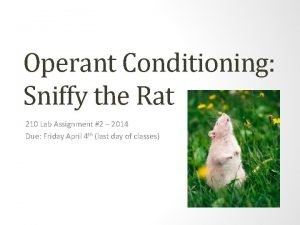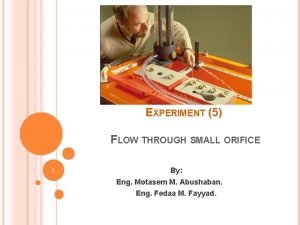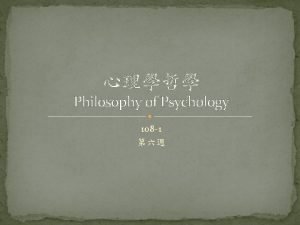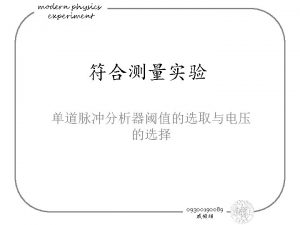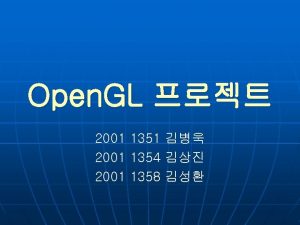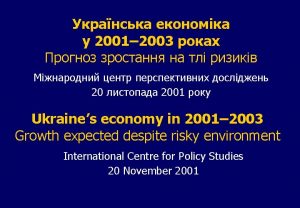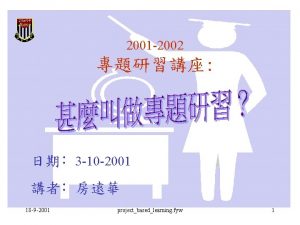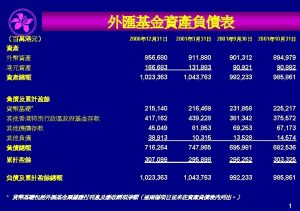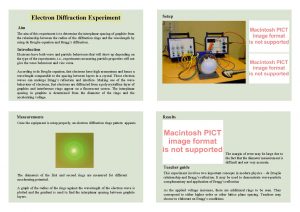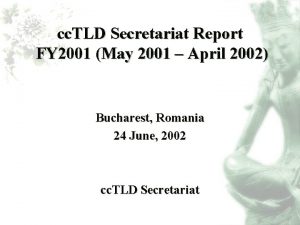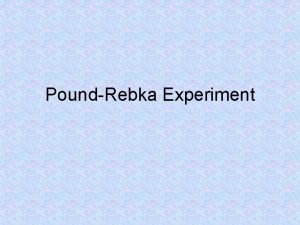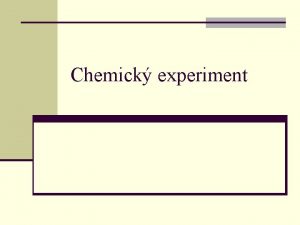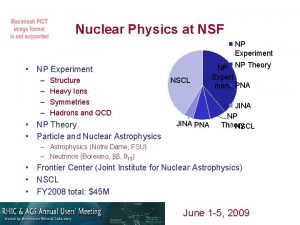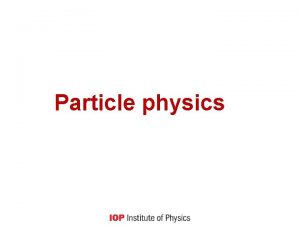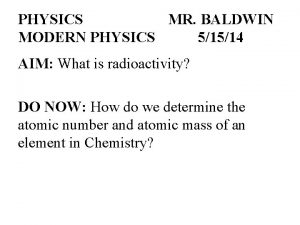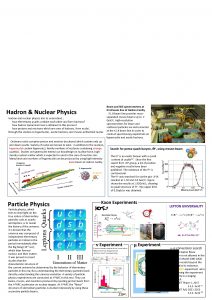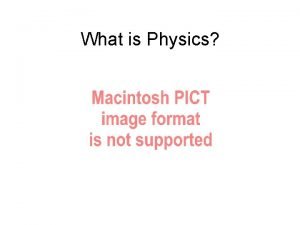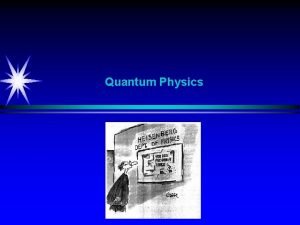Physics Experiment Report 2001 Aim of the experiment




















- Slides: 20

Physics Experiment Report 2001

Aim of the experiment ? Which one will reach the bottom first? Same mass & radius h h

Aim of the experiment Investigating relationship of the moment of inertia and the translation velocity of a ring and disk n conservation of energy n

Procedure n n n Set up the runway as shown on the table Attach the photogate at the lower end of the runway Suppose the height of the runway be h. Release the ring from the upper end measure the velocity when the ring reach the floor

Data and Results n n md = mr Rd = Rr Length of the disk and the ring that passes the sensor L = 8. 94*10 -2 m

Data and Results For Disk Time/t (s) Speed = L / t (ms-1) 0. 0946 0. 0955 0. 1022 0. 0974 Average speed = 0. 94548 0. 93657 0. 87689 0. 91838 0. 91931

Data and Results For Ring t 1 t 2 t 3 1. 3855 0. 0107 0. 1025 1. 6685 1. 5740 0. 0108 0. 1053 2. 0759 1. 9822 0. 0108 0. 1045 t 2+t 3 1. 4713 t=t 1 -

Data and Results For Ring Time/t (s) Speed = l / t (ms-1) 0. 1025 0. 1053 0. 1045 0. 87261 0. 84941 0. 85591 Average speed = 0. 85931

Data and Results Observation n n So it can be seen that the final speed of the disk is larger than that of the ring. i. e. Vd > Vr ……. ………(1)

Conclusion First investigation Do you know which one with higher value of moment of inertia ? The disk or the ring?

Conclusion First investigation Formula to calculate the moment of inertia of the disk is I = ½ * ( m * R 2 ) Now md = 0. 2 kg , Rd = 0. 06 m, Id = ½ * 0. 2 * ( 0. 06 ) 2 = 3. 6 * 10 -4

Conclusion First investigation Formula to calculate the moment of inertia of the ring is I = ½ * m ( R o 2 + R i 2 ) Now mr = 0. 2 kg , Ro = 0. 06 m, Ri = 0. 052 m Ir = ½ * 0. 2 * ( 0. 062 + 0. 0522 ) = 6. 304 * 10 -4

Conclusion First investigation ∴ Id < Ir . . . ………(2) Vd > Vr . . . ………(1) From (1) and (2), we can see that: Smaller is the moment of inertia; larger is the final speed.

Conclusion Second investigation n Total kinetic energy of the disk or the ring K. E. = ½ mv 2 + ½ I w 2 = ½ mv 2 + ½ I (V/r)2 n Loss in potential energy P. E. = mgh

Conclusion Second investigation So we should prove the following equation with the measured data. mgh = ½ mv 2 + ½ I

Conclusion Second investigation Now let’s discuss the disk first. md = 0. 2 kg Id = 3. 6 * 10 -4 n n h = 6. 5 cm = 0. 065 m Vd = 0. 91931 ms-1 R = 0. 06 m LHS = mgh = 0. 2 * 10 * 0. 065 = 0. 13 J RHS = ½ mv 2 + ½ I (V/R)2 = ½ * 0. 2 * ( 0. 91931 ) 2 + ½ * 3. 6 * 10 -4 * ( 0. 91931/0. 06 )2 = 0. 13 J n Energy is conserved ( for the disk ).

Conclusion Second investigation For the ring mr = 0. 2 kg Ir = 6. 304 * 10 -4 h = 6. 5 cm = 0. 065 m Vr = 0. 85931 ms-1 R = 0. 06 m LHS = mgh = 0. 2 * 10 * 0. 065 = 0. 13 J RHS = ½ mv 2 + ½ I (V/R)2 = 0. 13 J n Energy is conserved ( for the ring).

Conclusion First & Second investigation mgh = ½ mv 2 + ½ I (V/R)2 From this equation, we can see that smaller moment of inertia ( I ) gives larger value of V.

Error Resources / Experiment Precautions n n Air resistance acting on the disk/ring causes energy loss The disk/ring is not rolling in a straight line Human measuring error The disk/ring may be rolling down with slipping which will cause energy loss by the friction

The End Bye! That’s the end for our presentation How can we adjust the ring or disk so they reach the bottom at the same time?
 Linear and radial heat conduction
Linear and radial heat conduction Rock candy experiment lab report
Rock candy experiment lab report Sniffy experiment report
Sniffy experiment report Flow through an orifice experiment report
Flow through an orifice experiment report Current balance lab report
Current balance lab report Partial report experiment
Partial report experiment Modern physics vs classical physics
Modern physics vs classical physics University physics with modern physics fifteenth edition
University physics with modern physics fifteenth edition Ib physics
Ib physics Hát kết hợp bộ gõ cơ thể
Hát kết hợp bộ gõ cơ thể Slidetodoc
Slidetodoc Bổ thể
Bổ thể Tỉ lệ cơ thể trẻ em
Tỉ lệ cơ thể trẻ em Voi kéo gỗ như thế nào
Voi kéo gỗ như thế nào Chụp tư thế worms-breton
Chụp tư thế worms-breton Chúa yêu trần thế
Chúa yêu trần thế Các môn thể thao bắt đầu bằng tiếng bóng
Các môn thể thao bắt đầu bằng tiếng bóng Thế nào là hệ số cao nhất
Thế nào là hệ số cao nhất Các châu lục và đại dương trên thế giới
Các châu lục và đại dương trên thế giới Công thức tính thế năng
Công thức tính thế năng Trời xanh đây là của chúng ta thể thơ
Trời xanh đây là của chúng ta thể thơ


